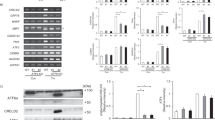Abstract
The yeast ALG7 gene functions by initiating the synthesis of the dolichol-linked oligosaccharide precursor and plays an important role in the control of protein N-glycosylation. The levels of ALG7 multiple transcripts are modulated by the physiological status of the cell and environmental cues, and deregulation of their abundance is deleterious to several cellular functions. Since ALG7 mRNAs are unstable, we investigated the role of these transcripts' half-lives in determining their steady-state levels. Using a temperature-sensitive RNA polymerase II mutant, we demonstrate that increased stability was the primary determinant of higher ALG7 mRNA abundance in response to glucose limitation or treatment with tunicamycin. In contrast, at the G1/G0 transition point, changes in the decay rates were inversely related to ALG7 transcript accumulation: the decreased abundance of ALG7 mRNAs following exit from the mitotic cycle was associated with lengthening of the decay rates, while their increased accumulation after growth stimulation correlated with decreased stability. This suggests that, depending on the circumstance, mRNA half-lives can either directly determine the level of ALG7 transcript accumulation or oppose regulatory changes at other control levels.
Similar content being viewed by others
References
Rademacher TW, Parekh RB, Dwek RA: Glycobiology. Ann Rev Biochem 57: 785–838, 1988
Varki A: Biological roles of oligosaccharides: all of the theories are correct. Glycobiol 3: 97–130, 1993
Fiedler K, Simons K: The role of N-glycans in the secretory pathway. Cell 81: 309–312, 1995
Lowe JB: Molecular cloning, expression and uses of mammalian glycosyltransferases. Cell Biol 2: 289–307, 1991
Moremen KW, Trimble RB, Herscovics A: Glycosidases of the asparagine-linked oligosaccharide processing pathway. Glycobiol 4: 113–125, 1994
Kukuruzinska MA, Bergh MLE, Jackson BJ: Protein glycosylation in yeast. Ann Rev Biochem 56: 915–944, 1987
Kukuruzinska MA, Lennon K: Diminished activity of the first N-glycosylation enzyme, dolichol-P-dependent N-acetylglucosamine-l-P transferase (GPT) gives rise to mutant phenotypes in yeast. Biochim Biophys Acta 1247: 51–59, 1995
Rine J, Hansen W, Hardeman E, Davis RW: Targeted selection of recombinant clones through gene dosage effects. Proc Natl Acad Sci USA 80: 6750–6754, 1983
Kukuruzinska MA, Lennon K: Growth-related coordinate regulation of the early N-glycosylation genes in yeast. Glycobiol 4: 437–443, 1994
Kukuruzinska MA, Robbins PW: Protein glycosylation in yeast: transcript heterogeneity of the ALG7 gene. Proc Natl Acad Sci USA 84: 2145–49, 1987
Pretel R, Lennon K, Bird A, Kukuruzinska MA: Expression of the first N-glycosylation gene in the dolichol pathway, ALG7, is regulated at two major control points in the G 1 phase of the Saccharomyces cerevisiae cell cycle. Exp Cell Res 219: 477–486, 1995
Lennon K, Pretel R, Kesselheim J, te Heesen S, Kukuruzinska MA: Proliferation-dependent differential regulation of the dolichol pathway genes in Saccharomyces cerevisiae. Glycobiol 5: 633–642, 1995
Mota O, Huang GT, Kukuruzinska MA: Developmental regulation and tissue-specific expression of hamster dolichol-P-dependent N-acetylglucosamine-l-P transferase (GPT). Biochem Biophys Res Comm 204: 284–291, 1994
Rajput B, Muniappa N, Vijay IK: Developmental and hormonal regulation of UDP-GlcNAc:Dol P GlcNAc-l-P transferase in mouse mammary gland. J Biol Chem 269: 16054–16061, 1994
Kukuruzinska MA, Apekin V, Lamkin M, Hiltz A, Rodriguez A, Lin CC, Paz MA, Oppenheim FG: Antisense RNA to the first N-glycosylation gene, ALG7, inhibits protein N-glycosylation and secretion by Xenopus oocytes. Biochem Biophys Res Comm 198: 1248–1254, 1994
Vai M, Popolo L, Alberghina L: Effect of tunicamycin on cell cycle progression in budding yeast. Exp Cell Res 171: 448–459, 1987
Peltz S, Brewer G, Bernstein P, Hart P, Ross J: Regulation of mRNA turnover in eukaryotic cells. Crit Rev Euk Gene Exp 1: 99–126, 1991
Herrick D, Parker R, Jacobson A: Identification and comparison of stable and unstable mRNAs in Saccharomyces cerevisiae. Mol Cell Biol 10: 2269–2284, 1990
Nonet M, Scafe C, Sexton J, Young R: Eucaryotic RNA polymerase conditional mutant that rapidly ceases mRNA synthesis. Mol Cell Biol 7: 1602–1611, 1987
Sherman F, Fink GR, Hicks JB: Methods in Yeast Genetics, Cold Spring Harbor Laboratory, Cold Spring Harbor, New York, 1986
Drebot MA, Veinot-Drebot LM, Singer RA, Johnston GC: Induction of yeast histone genes by stimulation of stationary-phase cells. Mol Cell Biol 10: 6356–6361, 1990
Osley MA, Gould J, Kim S, Kane M, Hereford L: Identification of sequences in yeast histone promoter involved in periodic transcription. Cell 45: 537–544, 1986
Xu H, Johnson L, Grunstein M: Coding and noncoding sequences at the 3' end of yeast histone H2B mRNA confer cell cycle regulation. Mol Cell Biol 10: 2687–2694, 1990
Arnold E, Tanner W: An obligatory role of protein glycosylation in the life of yeast cells. FEBS Letts 150: 309–313, 1982
Albertson NH, Nystrom T: Effects of starvation for exogenous carbon on functional mRNA stability and rate of peptide chain elongation in Echerichia coli. FEMS Microbiol Letts 117: 181–188, 1994
Zubiaga AM, Belasco JG, Greenberg ME: The nonamer UUAUUUAUU is the key AU-rich sequence motif that mediates mRNA degradation. Mol Cell Biol 15: 2219–2230, 1995
Muhlrad D, Parker R: Mutations affecting stability and deadenylation of the yeast MFA2 transcript. Genes Dev 6: 2100–2111, 1992
Beelman CA, Parker R: Degradation of mRNA in eukaryotes. Cell 81: 179–183, 1995
Shyu A-B, Greenberg ME, Belasco JG: Two distinct destabilizing elements in the c-fos message trigger deadenylation as a first step in rapid mRNA decay. Genes Dev 3: 60–72, 1989
Muhlrad D, Decker CJ, Parker R: Turnover mechanisms of the stable yeast PGKI mRNA. Mol Cell Biol 15: 2145–2156, 1995
Author information
Authors and Affiliations
Rights and permissions
About this article
Cite this article
Lennon, K., Bird, A., Chen, YF. et al. The dual role of mRNA half-lives in the expression of the yeast ALG7 gene. Mol Cell Biochem 169, 95–106 (1997). https://doi.org/10.1023/A:1006803004151
Issue Date:
DOI: https://doi.org/10.1023/A:1006803004151




